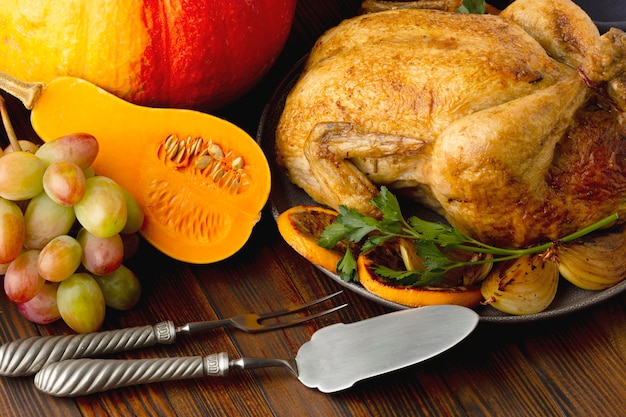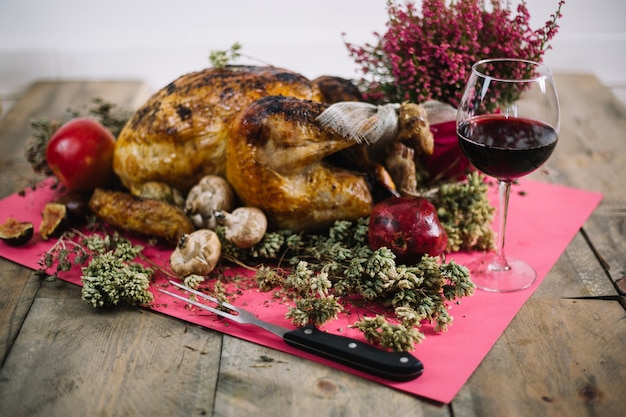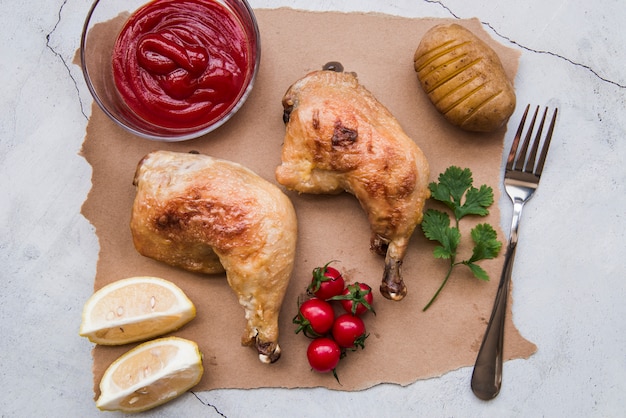You've got a cornish hen in your hands, and you're ready to turn it into a delicious meal. These little birds are a true culinary gem – perfect for a weeknight dinner or a special occasion. They’re small enough for quick cooking, yet big enough to be satisfying. And let's be honest, they're just adorable!
As a seasoned cook, I've had my fair share of culinary adventures with Cornish hens, from simple roast recipes to more elaborate creations. Today, I’m sharing my knowledge and favourite techniques to help you master this delightful bird. Grab a cuppa, settle in, and let’s get cooking!
(Part 1) Getting Started: Choosing and Preparing Your Hen

The first step is choosing the right hen. Personally, I steer clear of those pre-stuffed birds. They can be a tad dry, and the flavour tends to get lost. I prefer to stuff them myself, giving me control over the flavour and ensuring everything is cooked perfectly.
Finding the Perfect Hen
When you’re at the butcher’s, look for a hen that’s plump and has a good colour. The skin should be smooth and free from any bumps or bruises. You want a bird that’s been properly chilled. And don’t be afraid to ask the butcher for advice. They’re experts, you know, and they’ll be happy to help you choose the perfect bird.
Prepping Your Hen
Once you've got your hen home, give it a good rinse under cold water and pat it dry with kitchen paper. Depending on the recipe, you might want to remove the giblets – those little organs in the cavity. They’re often used for making stock, but I usually chuck ‘em. Just a personal preference.
Next, it’s time to season your hen. Salt and pepper are always a good starting point, but you can get creative with herbs and spices too. I love to use a mixture of thyme, rosemary, and garlic, rubbed all over the bird, inside and out.
(Part 2) Roasting Your Cornish Hen: A Classic Method

Roasting is the most traditional and easiest way to cook a Cornish hen. It's incredibly versatile too – you can roast it whole, or cut it up and roast the pieces separately.
Preheating and Roasting
First things first, preheat your oven to 180°C (350°F). You want the oven nice and hot to get that crispy skin. Grab a roasting tin and place the hen in it. You can add some vegetables to the tin, like carrots, potatoes, and onions. They’ll soak up all the lovely juices from the hen, making a delicious side dish.
Pour a little bit of water into the bottom of the tin. This will help create steam and keep the hen moist. And don’t forget to add some fat. A drizzle of olive oil or a knob of butter will do the trick.
Now, it’s time to cook the hen. Roast it for about 45 minutes to an hour, or until the internal temperature reaches 82°C (180°F). You can use a meat thermometer to check the temperature, or just stick a skewer into the thickest part of the thigh. If the juices run clear, it’s done.
Resting and Serving
Once the hen is cooked, let it rest for 10 minutes before carving. This allows the juices to redistribute and ensures a succulent and moist bird. Serve the hen with your favourite sides – roasted vegetables, mashed potatoes, or a simple green salad all go well.
(Part 3) Pan-frying Your Cornish Hen: A Quick and Easy Method

Pan-frying is another excellent way to cook a Cornish hen. It’s a bit quicker than roasting, and you get that lovely crispy skin. Plus, it’s easier to control the cooking process.
Getting Ready
You’ll need a large frying pan or skillet for this. Heat a tablespoon of oil over medium-high heat. While the oil is heating, pat your hen dry with kitchen paper. You don't want any excess moisture in the pan, as it could cause the hen to steam instead of fry.
Cooking the Hen
Place the hen in the hot pan, skin side down. Leave it to cook for about 5 minutes, or until the skin is golden brown and crispy. Then, carefully flip it over and cook the other side for another 5 minutes.
At this point, you can add some aromatics to the pan, like sliced onions, garlic, or herbs. They’ll infuse the hen with extra flavour.
Continue cooking the hen for another 5-10 minutes, or until the internal temperature reaches 82°C (180°F). Remember, you can use a meat thermometer to check the temperature.
Resting and Serving
Once the hen is cooked, remove it from the pan and let it rest for 5 minutes before carving. This allows the juices to redistribute and ensures a succulent and juicy hen. Serve it with your favourite sides, like roasted vegetables, mashed potatoes, or a green salad.
(Part 4) Stuffing Your Cornish Hen: Adding Flavor and Variety
This is where things get really fun. Stuffing a Cornish hen adds another dimension of flavour. You can use traditional bread-based stuffings, or get creative with vegetables, herbs, and even fruits.
Choosing Your Stuffing
I’ve got to say, a good bread-based stuffing is hard to beat. You can use leftover bread or buy some fresh bread and dry it out in the oven. Just remember to cut it into small pieces. Next, you’ll need some aromatics. I like to use onions, celery, and herbs like sage and parsley. Add some butter or olive oil for richness, and season generously with salt and pepper.
But don’t be afraid to think outside the box! You can add cooked grains like rice or quinoa to your stuffing for extra texture. Or add some chopped vegetables like mushrooms, leeks, or even some chopped apples or cranberries. Just remember to season them well.
Stuffing Your Hen
Once your stuffing is ready, gently spoon it into the cavity of the hen. Don’t overstuff it, as it’ll expand when it cooks. You can close the cavity with toothpicks or a piece of butcher’s twine.
Now, you can cook the hen according to your preferred method, whether it’s roasting, pan-frying, or even grilling.
(Part 5) Cornish Hen Recipes: Some of My Favorites
Let's dive into the good stuff. Here are a few of my favourite Cornish hen recipes. I've tried and tested these, so you know they're good.
1. roasted cornish hen with Lemon and Herbs
This recipe is simple and elegant, perfect for a special occasion. You’ll need:
- 1 Cornish hen
- 1 lemon, cut into wedges
- 2 tablespoons olive oil
- 1 tablespoon chopped thyme
- 1 tablespoon chopped rosemary
- Salt and pepper to taste
Instructions:
- Preheat your oven to 180°C (350°F).
- Rinse and pat the hen dry. Season it generously with salt and pepper.
- Rub the olive oil all over the hen. Then, tuck the lemon wedges under the skin of the hen.
- Sprinkle the thyme and rosemary all over the hen.
- Place the hen in a roasting tin and roast for 45-60 minutes, or until the internal temperature reaches 82°C (180°F).
- Let the hen rest for 10 minutes before carving. Serve it with your favourite sides.
2. Pan-fried Cornish Hen with Garlic and Thyme
This recipe is quick and easy, perfect for a weeknight meal.
- 1 Cornish hen
- 2 tablespoons olive oil
- 2 cloves garlic, minced
- 1 tablespoon chopped thyme
- Salt and pepper to taste
Instructions:
- Rinse and pat the hen dry. Season it generously with salt and pepper.
- Heat the olive oil in a large frying pan over medium-high heat.
- Place the hen in the pan, skin side down, and cook for 5 minutes, or until the skin is golden brown and crispy.
- Flip the hen over and cook the other side for another 5 minutes.
- Add the minced garlic and thyme to the pan and cook for 1 minute, or until fragrant.
- Continue cooking the hen for another 5-10 minutes, or until the internal temperature reaches 82°C (180°F).
- Let the hen rest for 5 minutes before carving. Serve it with your favourite sides.
3. Stuffed Cornish Hen with Sausage and Apples
This recipe is a bit more elaborate, but it's well worth the effort.
- 1 Cornish hen
- 1 pound sausage meat
- 1 apple, chopped
- 1/2 cup chopped onion
- 1/4 cup chopped celery
- 1 tablespoon chopped sage
- 1 tablespoon chopped parsley
- 1/4 cup chicken broth
- Salt and pepper to taste
Instructions:
- Preheat your oven to 180°C (350°F).
- In a large bowl, combine the sausage meat, apple, onion, celery, sage, parsley, and chicken broth. Season generously with salt and pepper.
- Spoon the stuffing into the cavity of the hen. Close the cavity with toothpicks or butcher’s twine.
- Place the hen in a roasting tin and roast for 45-60 minutes, or until the internal temperature reaches 82°C (180°F).
- Let the hen rest for 10 minutes before carving. Serve it with your favourite sides.
(Part 6) Serving and Enjoying Your Cornish Hen
Your hen is cooked and resting. Now it’s time to carve and serve. Here are a few tips to make your presentation look extra fancy.
Carving Your Hen
It’s best to use a sharp knife. You can use a carving knife if you have one, but a good chef’s knife will do the job.
Start by removing the legs. Place the hen on a cutting board, breast side up. Use your knife to cut along the joint between the leg and the body. Then, gently twist the leg to separate it from the body.
Next, remove the wings. Cut along the joint between the wing and the body. You can then cut the wing at the joint to make it easier to eat.
Finally, carve the breast meat. Use your knife to cut along the bone, separating the breast meat from the rib cage. You can then cut the breast meat into slices.
Presentation and Serving
You can arrange the carved hen on a platter, along with any roasted vegetables or other sides you’ve prepared. For a more rustic look, you can serve the hen directly on the roasting tin.
Serve the hen with your favourite sauces. A simple gravy or a lemon-herb sauce would be delicious. You can also add a touch of cranberry sauce or chutney.
(Part 7) Leftovers and Storage
Let’s be honest, there’s usually some leftover hen after a feast. And, good news, it's even better the next day! Here's how to store it and make it even tastier.
Storing Leftovers
Let the hen cool completely before storing it. Then, transfer it to an airtight container and store it in the refrigerator for up to 3 days.
Reheating Leftovers
There are a few ways to reheat leftover hen. You can heat it in the oven, microwave, or on the stovetop. For the oven, preheat it to 160°C (325°F) and heat the hen for about 15 minutes, or until it's heated through. For the microwave, heat the hen in 30-second intervals, stirring in between, until it's heated through. For the stovetop, heat some oil in a pan over medium heat and add the hen. Cook for about 5 minutes, or until heated through.
You can also use the leftover hen in other dishes. For example, you can chop it up and add it to a salad or soup, or you can use it to make a delicious sandwich.
(Part 8) Tips and Tricks for cooking cornish hen
Here are some extra tips and tricks that might come in handy.
1. Don't Overcook it
Cornish hens are delicate birds, so it's easy to overcook them. Make sure to cook them until they're just done, and no more. You want the meat to be tender and juicy, not dry and tough.
2. Season Generously
Don't be shy with the seasoning. Cornish hens have a delicate flavour, so they need a bit of extra oomph. Season them liberally with salt and pepper, and add your favourite herbs and spices.
3. Use a Meat Thermometer
A meat thermometer is your best friend when cooking Cornish hens. It helps you make sure the hen is cooked to the right temperature, ensuring a safe and delicious meal. The internal temperature should reach 82°C (180°F).
4. Rest the Hen Before Carving
Always let the hen rest for 10 minutes after cooking before carving it. This allows the juices to redistribute and ensures a juicy and tender bird.
(Part 9) FAQs
Here are some frequently asked questions about cooking Cornish hen.
1. How Long Does a Cornish Hen Need to Cook?
The cooking time for a Cornish hen depends on the cooking method you're using. For roasting, it will take about 45-60 minutes. For pan-frying, it will take about 15-20 minutes.
2. What Temperature Should I Cook a Cornish Hen?
The internal temperature of a Cornish hen should reach 82°C (180°F) to ensure it's cooked through. You can use a meat thermometer to check the temperature.
3. What Can I Serve with Cornish Hen?
Cornish hen goes well with a variety of sides, including roasted vegetables, mashed potatoes, green salads, and rice pilaf.
4. Can I Freeze Cornish Hen?
Yes, you can freeze Cornish hen. Wrap it tightly in plastic wrap and then aluminum foil. It can be frozen for up to 3 months. To thaw, place the hen in the refrigerator overnight.
5. What's the Difference Between a Cornish Hen and a Chicken?
A Cornish hen is a crossbreed of a Cornish chicken and a White Plymouth Rock chicken. They are smaller than regular chickens and have a more tender and flavorful meat. They also have a higher fat content, which contributes to their juiciness.
Cornish hens are also often called "fryers" because they're perfect for frying. They cook quickly and evenly, and the skin crisps up beautifully.
(Part 10) Cornish Hen: A Culinary Delight
There you have it – a comprehensive guide to cooking Cornish hens. Now you’re ready to cook up a storm with these delightful birds. Go on, give it a go. You’ll be surprised at how easy and delicious they are. And if you’ve got any questions, don’t hesitate to ask. Happy cooking!
Everyone is watching

How to Cook Frozen Lobster Tails Perfectly: A Step-by-Step Guide
RecipesLobster. Just the word conjures up images of lavish meals, special occasions, and a taste of luxury. But let's...

Pigs in a Blanket Cooking Time: How Long to Bake for Perfect Results
RecipesAh, pigs in a blanket. Just the name conjures up images of those delightful little parcels of crispy pastry en...

Pork Fillet Cooking Time: How Long to Cook It Perfectly
RecipesPork fillet, or tenderloin as it's sometimes called, is a real favourite in our house. It's so versatile, and...

The Ultimate Guide to Tender, Juicy Pulled Pork
RecipesRight, let's talk pulled pork. It's one of those dishes that just screams "comfort food," doesn't it? I mean...

The Ultimate Guide to Cooking Delicious Frankfurters
RecipesLet's face it, we all love a good frankfurter. It's a classic, simple, and always satisfying. But let's be rea...
